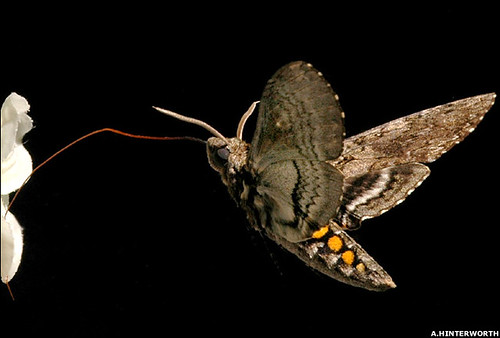Researchers have discovered that moth antennae have gyroscope-like sensors to help them control their flight through the air. Because they fly at night, the source of their smooth and graceful flight was a mystery because they could not rely on visual cues.
But a research team headed by Sanjay Sane, a biologist at the University of Washington, Seattle, found a structure at the base of the antennae that senses when the moth's body begins to pitch or roll, it relays this information to the brain, which causes the body to compensate.
"Whenever a creature is moving about, it has to have sensory information to tell it what it has done," said Sane. "If a person unintentionally turns around, the inner ear system or eyes will provide that information and allow for a course correction. Flying creatures need to know that information too, and when the light is low, and the visual cues are hard to see, they have to depend more on the mechanosensory system."
In a particularly elegant series of experiments, the researchers found that removing the antennae caused the moths to collide with walls, to fly backwards or crash to the floor. However, when the antennae were glued back in place, the moths regained their maneuverability.
Closer examination revealed that a structure, called Johnston's organ, found at the base of the moths' antennae, was crucial for flight stability. This organ relies on vibrations from the antennae, which remain in a fixed position during flight, to detect the spatial relationship of the moth's body to its antennae, behaving like a gyroscope.
Johnston's organ sends this information to the moth's brain, which then tells the moth to shift its body back to the correct spatial position.
Previous studies found that two-winged insects, such as house flies or mosquitoes, also use gyroscope-like sensors to control their flight. These are the "halteres" that are attached to their hindwings.
Cited story.
.


Oh No! This is terrible! Now all the "Intelligent Design" idiots at the Discovery Institute in Seattle, that couldn't get enough of the bacterial flagella looking designed are going to be all over this as a whole new line of BS... Friggin gyroscopes!
Actually this is very cool, and it's not your fault, or the fault of the scientists that actually did the research, and discovered this. See IDists? THIS is what science is, not just spouting off, but doing work other than putting out press releases!
Heh. J-Dog, you beat me to it. That is exactly what I was going to try to point out. :)
But you didn't answer the obvious question: Ok, how the heck does something like this "evolve"?
Humor me. I am but a lowly creationist.
z.
Wow, pretty cool story. Though I'm not sure I'd call clipping body parts off and then re-gluing them to moths as "elegant" - but hey, that's just me.
Simple evolution mechanism thought - take a moth that doesn't pay attention to it's antennae position. Take a moth that does. The moth that pays attention should be more maneuverable in the air, and more likely to evade predators.
For a while I was thinking: "moth antennae can sense EM radiation; do they have laser ring gyros?" Then I realized what a goofy idea that was. Evolution is cool, but not as wacky as a science fiction writer's runaway imagination.